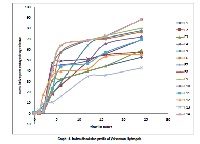Design and Invitro Evaluation of Modified release Valsartan Hydrogels.
Keywords:
Soluplus, Xanthan gum, Acrylamide, Hydrogels, diffusion, controlled releaseAbstract
An attempt was made to develop a novel cross-linked soluplus-xanthan gum-acrylamide hydrogels of valsartan by entrapping the hydrophobic drug initially in a novel polymeric solubilizer, soluplus and then hydrogels were prepared using Xanthan gum and acrylamide in as controlled release polymers in different ratios using methylene bisacrylamide as cross linking agent and Potassium persulphate as an initiator. The formulations were characterized by FTIR and DSC for compatibility, SEM for their surface morphology, swelling kinetics and in vitro drug release. FTIR and DSC showed no chemical interaction between the drug and the polymers. SEM revealed the surface morphology of the hydrogel systems before and after swelling. A significant difference of swelling behavior was observed in different media. But a dependence of the equilibrium of swelling on the pH was found to be higher in basic media when compared to the acidic. In vitro release pattern indicated that formulation 14 showed a better release of 88.27% for a period 24 hrs with 81% of swelling in phosphate buffer of pH 6.8. It was also observed that the release rate was found to be increased when the concentration of crosslinking agent was increased. The kinetic release pattern was further confirmed that it followed a zero-order non-fickian diffusion controlled release with supercase-II transport mechanism.
References
Bae, Y.H., Kim, S.W., 1993. Hydrogel delivery systems based on polymer blends, block co-polymers or interpenetrating networks. Adv. Drug Delivery Rev. 11, 109-135.
Bhalerao VS, Varghese S, Lele AK, Badiger MV. Thermoreversible hydrogel based on radiation induced copolymerisation of poly (N-isopropyl acrylamide) and poly(ethylene oxide). Polymer 1998; 39:2255-60.
Brown, W., Johnsen, R.M., 1981. Diffusion in polyacrylamide gels. Polymer 22, 185-189.
E.D. Goddard. J.V. Grubber, in; E.D. Goddard. J.V. Grubber(Eds), princilples of polymer science and Technology in cosmetics and personal care. Marcel Dekker; NewYork, (1999), 342.
F.Jiangyang, W. Kang, L. Meimei, H.Zhimin, Carbohydr.polym.73 (2008) 241-247.
Gehrke, S.H., 1993. Synthesis, equilibrium swelling, kinetics, permeability and applications of environmentally responsive gels. Adv.Polym.Sci. 110, 81-144.
Hoffman, A.S., 2002.Hydrogels for biomedical applications. Adv.Drug Delivery Rev.43, 3-12.
Howida Kamal Ibrahim and Doaa A. El-Setouhy., 2010 Valsartan Orodispersible Tablets: Formulation, In vitro/In vivo Characterization. AAPS PharmSciTech, Vol. 11, No. 1, 189-196
K.E.Uhrich, S.M. Cannizzaro, R.S. Langer, K.M. Shakesheff, polymer systems for controlled drug release, Chem. Rev. 99 (1999) 3181-3198.
Korsemeyer, R.W., Rave, T.L., Peppas, N.A., Gunny, R., Delker, E., Buri, P.A., 1982. Swelling controlled release systems; progress toward zero-order kinetics with polymer blends. Proc. Int. Symp. Control. Release Bioact. Mater. 9, 65-68.
Lead, J.R., Starchev, K., Wilkinson, K.J., 2003. Diffusion coefficients of humic sunstances in agarose gel and in water. Environ.Sci. Technol. 37, 482-487.
Leonard M, Rastello De Boisseson M, Hubert P, Dalencon F, Dellacherie E. Hydrophobically modified alginate hydrogels as protein carriers with specific controlled release properties. J Control Release 2004; 98:395-405.
Luke M.Geever, Ciaran C.Cooney, John G. Lyons, James E. Kennedy, Michael J.D. Nugent, Sinead Devery, Clement L. Higginbotham, Characterization and controlled drug release from novel drug-loaded hydrogels, Eur.j. Pharm. Biopharm 69(2008) 1147-1159.
N.A.Peppas, P. Bures, W. Leobandung, H.Ichikawa, Hydrogels in Pharmaceutical formulations. Eur.J.Biopharm. 50 (2000) 27-46.
Palapparambil Sunny Gils, Debajyoti Ray, Prafulla Kumar Sahoo, Int.j.Biol.Macromol. 45 (2009) 364-371.
Ritger, P.L., Peppas, N.A., 1987. A simple equation for description of solute release. I. Fickian and non-Fickian release from non-swellable devices in the form of slaps, spheres, cylinders or discs. J.Control. Release 5, 23-36.
S.Brahim, D.Narinesingh, A.K.Swain, T.K.Pal, P.K. Sahoo.j.Appl.Polym.Sci, 108 (2008) 380-386.
Satish CS, Satish KP, Shivakumar HG. Hydrogels as controlled drug delivery systems: Synthesis, crosslinking, water and drug transport mechanism. Indian J Pharm Sci 2006; 68:133-40.
Sumathi, S., Ray, A.R., 2002. Release behavior of drugs from tamarind seed polysaccharide tablets. J. Pharm.Pharm.Sci. 5, 12-18.
Tabata, Y., Ikada, Y., 1998. Protein release from gelatin matrices. Adv. Drug Delivery Rev. 31, 287-301.
Tommasina Coviello, Pietro Matricardi, Carlotta Marianecci, Franco Alhaique, Polysaccharide hydrogels for modified release formulations, J.Cont.Rel, 119 (2007) 5–24.
T.Simonida, S.Edin.F.Jovanka, Polym.Bull, 57 (2006) 691-702.
Uhrich,K.E., Cannizzaro, S.M., Langer, R.S., Shakeshoff, K.M., 1999. Polymeric systems for controlled drug release. Chem.Rev. 99, 3181-3198.
The Biopharmaceutics Classification System (BCS) Guidance, Office of Pharmaceutical





